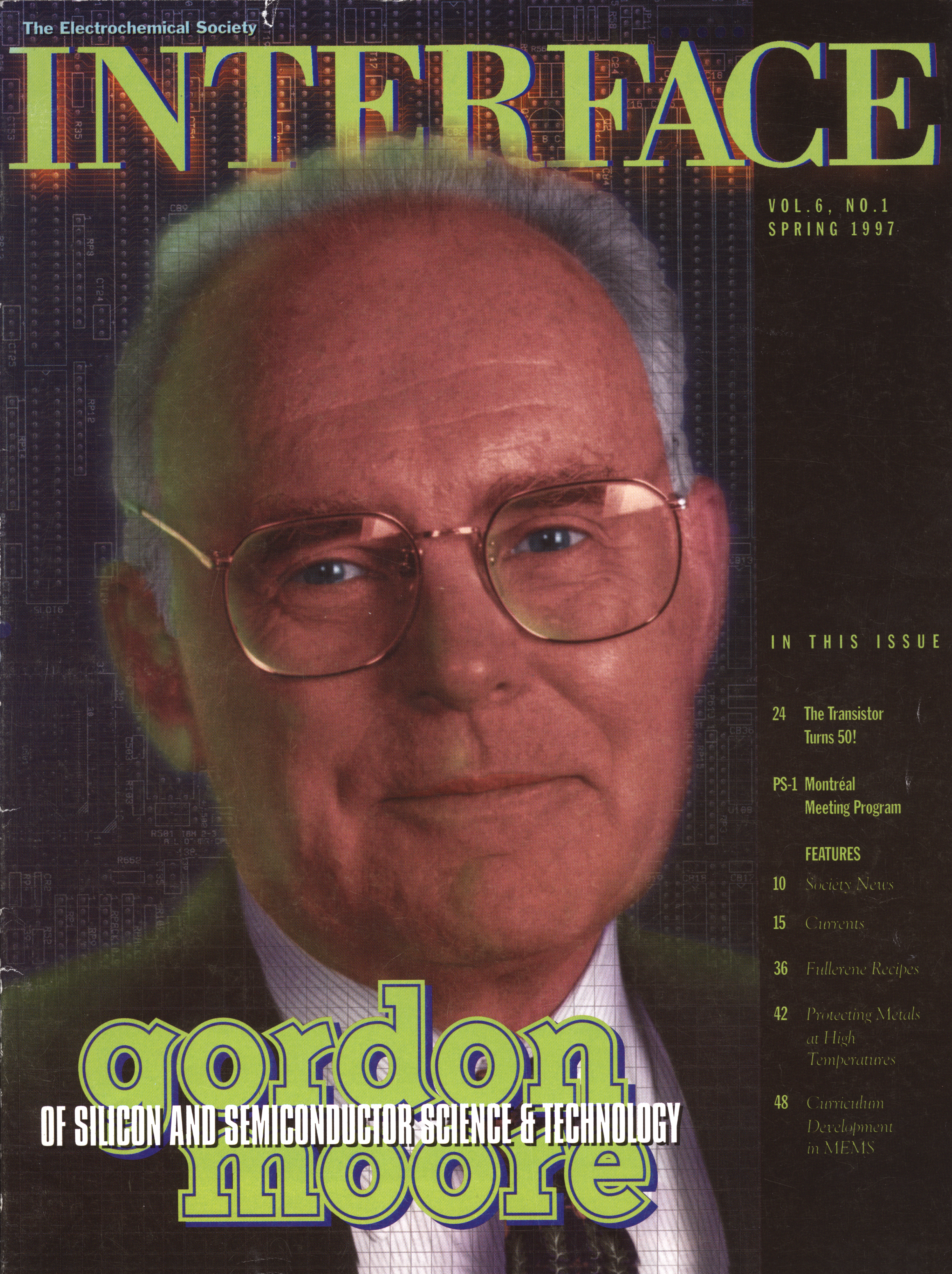In 1965, Moore’s law forever changed the world of technology. In that year, Gordon Moore wrote an article predicting the future of the semiconductor industry—a prophecy that shaped the modern technology industry, giving early startups the confidence to invest in electronics. The law, which states that the number of transistors on a silicon chip would double every year (later revised to every two years), has paved the way for companies to make faster, smaller, and more affordable transistors for over 50 years—setting the pace for the modern digital revolution.
While Moore may have put his prediction in writing in 1965, the ideas surrounding the phenomenon began taking root before he put pen to paper. In a recent interview that ECS conducted with Moore, he said his vision that the number of transistors per chip would double every two years was articulated in public for the very first time at an ECS meeting of the Society’s San Francisco Section in 1964.
“I was thinking about those kinds of things at that time,” Moore recalled in a recent conversation with ECS. “That meeting was right around the time I was writing the article for Electronics.”
Solid state shift
In 1947, the stage was being set for a major change in the world of electronics, and the catalyst for that change was Bell Labs’ development of the transistor, which is the key technology behind modern day electronics. The development of the transistor would not only lead to a surge in solid state science, but also a major shift in ECS.
By the time Moore joined ECS in 1957, the membership of the Society’s Electronics Division had swelled tremendously—making it the largest Division in the Society at that time. With guidance from Moore and other young solid state revolutionaries, ECS’s Electronics Division began moving away from technologies that blossomed with the advent of the television (i.e., phosphors for fluorescent light bulbs and cathode ray tubes) in lieu of new, vibrant technologies growing out of Bell Labs in New Jersey and the San Francisco Bay Area.
“There were a large number of semiconductor companies in the Bay Area,” Moore says. “There were a variety of papers that related to the semiconductor business, so we were seeing a change.”
Evolving technology of the semiconductor
In addition to the shift happening in the Society’s Electronics Division, a similar change was happening simultaneously in the Society’s San Francisco Section—the Section that Moore often referred to as his home court.
By the mid- to late-1960s, the dramatic buildup of the semiconductor industry resulted in the Section’s shifted interests toward solid state topics. Moore presented a talk toward the end of 1964 at ECS’s San Francisco Section meeting entitled, “The Evolving Technology of the Semiconductor Integrated Circuits,” where he began to lay out the underlying foundation of Moore’s law and his vision for the future potential of semiconductor electronics.
“A low-key start”
This from Moore’s Law: The Life of Gordon Moore, Silicon Valley’s Quiet Revolutionary:
In prior publications, (Moore) had laid out his ideas; now it was time to convey his insights to the technical community as compellingly as he could and to convince others about the future of electronics. Preaching his message would take practice, hence a low-key start on home turf, with a talk on December 2, [1964] to a local section of The Electrochemical Society on the San Francisco Peninsula.
In his talk, Moore stated that, “The evolution of integrated circuit technology will be reviewed and extrapolated into the future. An attempt will be made to indicate the extent of the revolution of electronics that will be precipitated as a result of these technological advances.”
Over 65 years and counting
Much has changed in the computing and electronics industries over the past 65+ years, but the iconic Moore’s law still guides Silicon Valley and the technology industry at large.
“The fact that we’ve been able to continue [Moore’s law] this long has surprised me more than anything,” Moore said. “There always seems to be an impenetrable barrier down the road, but as we get closer to it, people come up with solutions.”
While the law has proven correct for the past five decades, some researchers believe it could be hitting a plateau. As for Moore, he believed that there are certainly limitations in the horizon—nothing, however, that could trump the semiconductor industry.
“To me, it’s very difficult to replace semiconductor technology,” Moore said. “It’s a result of several billion dollars of R&D investments and instead of being replaced, it’s penetrating other fields more and more all the time. I would be very reluctant to say something like quantum computing or the other ideas out there right now could come along and replace the semiconductor technology.”
Moore’s impact
Over 65 years later, Moore’s theory that defined the tech industry is still driving the progress of electronics. What Moore said in the spring 1997 issue of ECS’s member magazine Interface—with him featured on the cover—still rings true today:
“We have a fair ways to go just to continue to push the technology to smaller and smaller things, higher and higher performance,” Moore said. “The people who use that technology to make products will then have billions of transistors on a chip to work with, and that gives them almost open-ended possibilities.”
Moore joined ECS in 1957 and was a member until his death in 2023. In 2005, the ECS Solid State Science and Technology Award was renamed through a $150,000 endowment from Intel in honor of its co-founder. The Gordon E. Moore Medal for Outstanding Achievement in Solid State Science & Technology honors scientists and engineers making distinguished contributions to the field of solid state science. The Society named Moore an Honorary Member in 2007.






